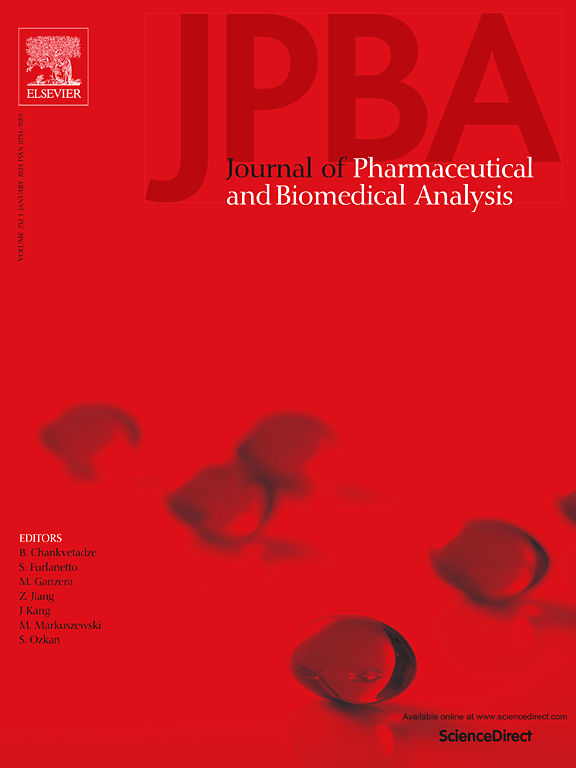利用 LC-HRMS/MS 表征含有环肽 Linaclotide 的二硫桥及其降解产物。
IF 3.1
3区 医学
Q2 CHEMISTRY, ANALYTICAL
Journal of pharmaceutical and biomedical analysis
Pub Date : 2024-10-17
DOI:10.1016/j.jpba.2024.116533
引用次数: 0
摘要
利那洛肽(LINA)是一种首创的鸟苷酸环化酶激动剂,用于治疗肠易激综合征伴便秘(IBS-C)和慢性特发性便秘。根据国际药品协调技术委员会(ICH)指南 Q1A (R2),对 LINA 进行了应力降解研究,以检测其内在稳定性。本研究试图通过暴露于各种应力条件下来阐明 LINA 的稳定性。研究人员使用 Waters Symmetry C18 色谱柱(150 ×4.6 mm,3.5 µm)作为固定相,开发了一种简单的液相色谱法,用于有效分离所有的 LINA 降解产物。利用高分辨质谱(LC-HRMS)和 MS/MS 研究对生成的降解产物进行了鉴定和表征。建立了七种降解产物的机械破碎途径,并阐明了已鉴定降解产物的化学结构。LINA在酸性、碱性、中性、光解和氧化条件下均易降解。在以甲醇为助溶剂的酸性条件下,总共形成了三种伪 DPs,即 DP-1、DP-2 和 DP-3。此外,还发现了降解产物(DPs):在碱性应力条件下形成 DP-4,在中性、热和光解条件下形成 DP-5。此外,在氧化应力条件下形成了 DP-6 和 DP-7。这项研究建立了机械破碎途径,并阐明了降解产物的化学结构,为仿制药和新型制剂药物的开发提供了宝贵的启示。本文章由计算机程序翻译,如有差异,请以英文原文为准。
Characterization of disulfide bridges containing cyclic peptide Linaclotide and its degradation products by using LC-HRMS/MS
Linaclotide (LINA) is a first-in-class guanylate cyclase agonist used for treating irritable bowel syndrome with constipation (IBS-C) and chronic idiopathic constipation. Stress degradation studies were performed to examine LINA's intrinsic stability, adhering to International Council for Harmonisation of Technical ICH) guidelines Q1A (R2). The current study endeavours to elucidate the stability behavior of LINA by exposing various stress conditions. A simple LC method was developed for effective separation of all LINA degradation products using a Waters Symmetry C18 column (150 ×4.6 mm, 3.5 µm) as the stationary phase. The generated degradation products were identified and characterized by using high-resolution mass spectrometry (LC-HRMS), MS/MS studies. The mechanistic fragmentation pathway for the seven degradation products was established and the chemical structure for the identified degradation products was elucidated. LINA was susceptible to degrade under acidic, basic, neutral, photolytic, and oxidative conditions. A total of three Pseudo DPs, DP-1, DP-2, and DP-3, were formed under acidic conditions while using methanol as the co-solvent. Additionally, degradation products (DPs) were identified: DP-4 formed under basic stress condition and DP-5 under neutral, thermal, and photolytic conditions. Furthermore, DP-6 and DP-7 were formed under oxidative stress condition. This study established the mechanistic fragmentation pathways and elucidated the chemical structures of the degradation products, offering valuable insights for generics and novel formulation drug development.
求助全文
通过发布文献求助,成功后即可免费获取论文全文。
去求助
来源期刊
CiteScore
6.70
自引率
5.90%
发文量
588
审稿时长
37 days
期刊介绍:
This journal is an international medium directed towards the needs of academic, clinical, government and industrial analysis by publishing original research reports and critical reviews on pharmaceutical and biomedical analysis. It covers the interdisciplinary aspects of analysis in the pharmaceutical, biomedical and clinical sciences, including developments in analytical methodology, instrumentation, computation and interpretation. Submissions on novel applications focusing on drug purity and stability studies, pharmacokinetics, therapeutic monitoring, metabolic profiling; drug-related aspects of analytical biochemistry and forensic toxicology; quality assurance in the pharmaceutical industry are also welcome.
Studies from areas of well established and poorly selective methods, such as UV-VIS spectrophotometry (including derivative and multi-wavelength measurements), basic electroanalytical (potentiometric, polarographic and voltammetric) methods, fluorimetry, flow-injection analysis, etc. are accepted for publication in exceptional cases only, if a unique and substantial advantage over presently known systems is demonstrated. The same applies to the assay of simple drug formulations by any kind of methods and the determination of drugs in biological samples based merely on spiked samples. Drug purity/stability studies should contain information on the structure elucidation of the impurities/degradants.

 求助内容:
求助内容: 应助结果提醒方式:
应助结果提醒方式:


